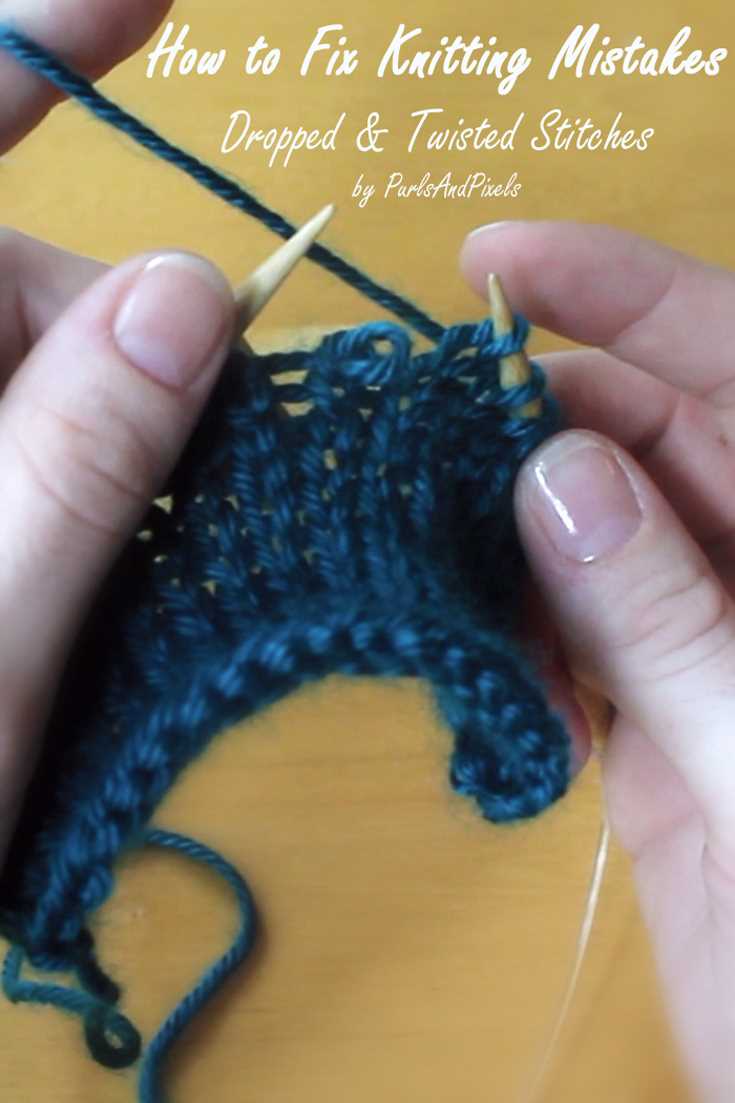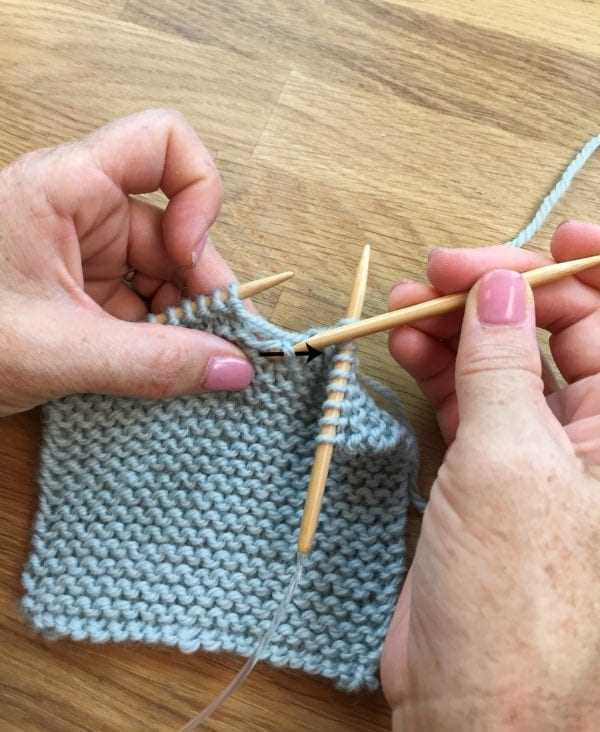If you’re an avid knitter, you know how frustrating it can be to drop a stitch. Whether you’re a beginner or an experienced knitter, it’s bound to happen at some point. But don’t worry, fixing a dropped knit stitch is easier than you might think! In this article, we’ll walk you through some quick and easy solutions to help you fix a dropped knit stitch and get your project back on track.
When you drop a knit stitch, it can be tempting to panic and start undoing your work in an attempt to fix it. However, this can often make the problem worse and create more dropped stitches. Instead, take a deep breath and follow these simple steps to fix the issue.
The first step is to identify where the dropped stitch occurred. Look closely at your work and you should be able to spot the dropped stitch, as it will appear as a horizontal bar running across your fabric. Once you’ve located the dropped stitch, use a crochet hook or a spare knitting needle to pick it up and bring it back into place. Make sure to catch the loose strands of yarn as well, to prevent any unraveling.
Once you’ve picked up the dropped stitch, you can secure it by knitting or purling it, depending on the stitch pattern you’re working with. Simply insert your needle into the dropped stitch, and then proceed to knit or purl it as you would a regular stitch. This will help to close up the gap created by the dropped stitch and ensure that your fabric looks even and seamless.
In some cases, you may find that the dropped stitch has created a ladder effect, with multiple stitches dropping down in a column. Don’t panic! You can easily fix this by using a crochet hook or spare knitting needle to “weave” the dropped stitches back up the column. Simply insert the hook or needle into each dropped stitch, and then pull it back up to the correct row. Once all the stitches are back in place, you can secure them by knitting or purling them as described above.
Remember, fixing a dropped knit stitch is just a part of the knitting process. It’s important not to get discouraged and to see it as an opportunity to learn and improve your skills. With a little practice and patience, you’ll soon be able to fix dropped knit stitches with ease and continue creating beautiful projects.
Identifying a Dropped Knit Stitch
When knitting, it’s not uncommon to make mistakes or drop stitches along the way. One common knitting mistake is dropping a knit stitch. If you’re not sure whether you’ve dropped a stitch or not, here are some signs to look out for:
- Uneven Rows: If you notice that one row looks uneven compared to the others, it could be a sign that you’ve dropped a stitch. The dropped stitch might create a visible ladder or gap in your knitting.
- Extra Loops: Another sign of a dropped knit stitch is if you see extra loops or enlarged stitches in your work. These loops can occur when the yarn is not properly interlaced with the previous row’s stitch.
- Misaligned Stitches: Dropped stitches can cause the stitches above or below them to become misaligned. This can result in a skewed or distorted appearance in your knitting.
If you notice any of these signs, it’s likely that you have dropped a knit stitch in your knitting project. Don’t worry though, fixing a dropped knit stitch is easier than you might think!
Tools You’ll Need
Fixing a dropped knit stitch is a relatively simple process, but you’ll need a few tools to help you along the way. Here are the tools that you’ll need:
- Tapestry Needle: This is a large-eyed needle with a blunt tip, which makes it perfect for weaving in yarn ends and fixing dropped stitches.
- Crochet Hook: A crochet hook can be helpful in catching and working with dropped stitches. Choose a crochet hook that is similar in size to the knitting needles you’re using for the project.
- Stitch Markers: Stitch markers can be used to mark the location of dropped stitches, making them easier to find and fix.
- Small Scissors: You’ll need small scissors to cut any excess yarn or thread after fixing the dropped stitch.
- Optional: Highlighter or Pen: If you’re having trouble keeping track of your stitches, you can use a highlighter or pen to mark the rows or stitches that need to be fixed.
Having these tools on hand will make the process of fixing a dropped knit stitch much easier and more efficient. Make sure you gather all the necessary tools before you begin fixing your dropped stitch!
Method 1: Using a Crochet Hook
One of the easiest and quickest ways to fix a dropped knit stitch is by using a crochet hook. Follow these steps to fix the dropped stitch:
- Identify the dropped stitch: Look for any loose or hanging loops in your knitting. These loops indicate a dropped stitch.
- Unravel the stitch: Carefully unravel the dropped stitch to the point where it should have been secured. Be gentle to avoid further damage.
- Insert the crochet hook: Insert a crochet hook through the loop of the dropped stitch from front to back.
- Hook the stitch: Use the crochet hook to grab the strand of yarn that should have been pulled through the dropped stitch. Pull the strand of yarn through the loop onto the crochet hook.
- Pull the loop through: Gently pull the loop of the dropped stitch through the stitch that was pulled through with the crochet hook. Make sure the loop is secured on the needle.
- Continue knitting: Once the dropped stitch is fixed, continue knitting as usual. Ensure that the newly fixed stitch is not too tight or loose.
Using a crochet hook to fix a dropped knit stitch is a simple and effective method. It allows you to quickly rescue your knitting project without having to unravel the entire row.
Method 2: Using a Darning Needle
If you prefer a more hands-on approach or find that the crochet hook method isn’t working for you, you can try fixing the dropped knit stitch using a darning needle. This method involves using a needle to carefully weave the dropped stitch back into place.
- Gather your materials: To fix the dropped knit stitch using a darning needle, you will need a darning needle, a crochet hook or knitting needle in a smaller size, and any necessary yarn or thread.
- Identify the dropped stitch: Take a close look at your work and locate the dropped stitch. It will be a vertical loop that has slipped off the needle.
- Thread the darning needle: Thread the darning needle with a contrasting yarn or thread that is at least double the length of the dropped stitch.
- Insert the darning needle: Insert the darning needle from front to back into the dropped stitch. Make sure to leave a tail of yarn or thread on the front side of the work.
- Weave the needle: Use the darning needle to weave the yarn or thread through the surrounding stitches, following the path of the original stitch. Be careful to not split the yarn or create any additional loops.
- Tighten and secure: Once the dropped stitch is firmly in place, gently tighten the surrounding stitches to ensure an even tension. You can use a crochet hook or knitting needle in a smaller size to adjust the tension if needed.
- Weave in the ends: Finally, trim any excess yarn or thread and weave in the ends using a darning needle to secure them.
Using a darning needle to fix a dropped knit stitch can be a slower process compared to other methods, but it allows for more control and precision. It is a great option for fixing more complex patterns or delicate stitches where accuracy is important.
Method 3: The Lifeline Technique
If you’re working on a complex knitting pattern or are worried about dropping stitches, the lifeline technique can be a great preventative measure. This technique involves threading a lifeline through your stitches every few rows, creating a safety net in case you drop a stitch.
- Select a Thin Yarn or Dental Floss: Choose a thin yarn or dental floss that is a contrasting color to your project. This will make it easier to see the lifeline and remove it later.
- Thread the Lifeline: Thread a tapestry needle with the thin yarn or dental floss. Insert the needle through the stitches on your knitting needle, making sure to go under the yarn strands between each stitch.
- Create a New Row: Continue knitting as usual, making sure to incorporate the lifeline into each row. When you reach the end of each row, thread the lifeline through the stitches again.
- Fixing a Dropped Stitch: If you drop a stitch, the lifeline will prevent it from unraveling further. To fix the dropped stitch, carefully unravel your work to the lifeline row. Once you’ve reached the lifeline, use a crochet hook or knitting needle to catch the dropped stitch and bring it back to the correct row. Then, reinsert your knitting needle into the stitches on the lifeline and continue knitting.
- Removing the Lifeline: Once you’ve finished your project and are confident that all stitches are secure, the lifeline can be easily removed. Gently tug on one end of the lifeline to slide it out of the stitches.
The lifeline technique can provide peace of mind when working on intricate or complicated knitting patterns. By taking the time to thread a lifeline every few rows, you’ll have a safety net in place to catch any dropped stitches and minimize potential damage to your work.
Preventing Dropped Knit Stitches
Knitting is a relaxing and creative hobby, but it can be frustrating when you drop a stitch. However, there are several things you can do to prevent dropped knit stitches and minimize the chances of making mistakes.
1. Use stitch markers: Place stitch markers at regular intervals in your knitting to help you keep track of your stitches. They act as a visual guide and make it easier to spot any mistakes before they become a bigger problem.
2. Count your stitches frequently: It’s easy to lose track of your stitch count, particularly when you’re working on a complex pattern. Make it a habit to count your stitches after completing each row or round to catch any discrepancies early on.
3. Keep an eye on your tension: Maintaining consistent tension in your knitting is crucial for preventing dropped stitches. If your tension is too loose, the stitches can slip off the needle more easily. Practice keeping an even tension as you knit to avoid this problem.
4. Use lifelines: Lifelines are a great tool for safeguarding your work. They involve threading a contrasting waste yarn through a row of stitches at regular intervals. If you make a mistake, you can easily rip back to the lifeline and ensure you don’t drop any stitches.
5. Avoid distractions: Knitting requires focus and concentration. Try to create a quiet and calm environment when you work on knitting projects to minimize the chances of making mistakes and dropping stitches.
6. Practice good needle placement: Pay attention to how you place your stitches on the needle. Make sure they are snugly seated on the needle and not hanging loosely. This will help prevent dropped stitches and create a more even fabric.
7. Learn to fix mistakes: Even with careful attention, mistakes can happen. Understanding how to fix dropped stitches quickly and effectively is an essential skill for any knitter. Take the time to learn different methods for fixing mistakes so you can confidently tackle them when they occur.
By following these tips and practicing good knitting habits, you can reduce the chances of dropped stitches and enjoy a smoother knitting experience.
Fixing Mistakes in Lace Knitting
Lace knitting can be a beautiful and intricate technique, but it also leaves room for mistakes. Here are some common mistakes in lace knitting and how to fix them:
- Dropped Stitch: If you notice a dropped stitch in your lace knitting, use a crochet hook or a small knitting needle to pick up the stitch and place it back on the needle. Be careful not to twist the stitch as you pick it up.
- Extra Yarn Overs: Sometimes, extra yarn overs can be created unintentionally, causing your lace pattern to be off. To fix this, identify the extra yarn over and drop it off the needle. Then, unravel the stitches below it until you reach the extra yarn over and re-knit the stitches correctly.
- Twisted Stitches: Twisted stitches can occur when you accidentally knit or purl through the back loop instead of the front loop. To fix this, identify the twisted stitch and carefully unravel the stitch below it until you reach the twisted stitch. Then, insert the needle into the stitch correctly and re-knit or purl it.
- Missing or Misplaced Decreases: Lace patterns often include decreases to create the intricate designs. If you notice a missing or misplaced decrease, carefully unravel the stitches below it until you reach the decrease. Then, correctly execute the decrease and re-knit the stitches.
- Pulling or Tightness: Sometimes, lace knitting can become too tight or pull unevenly. To fix this, gently stretch the fabric with your hands while it is still on the needles to redistribute the tension. If needed, you can also block the finished piece to even out the stitches.
Remember, fixing mistakes in lace knitting requires patience and attention to detail. Take your time and carefully undo and redo the stitches as needed. With practice, you will become more comfortable in fixing mistakes and creating beautiful lace knitting projects.
Additional Tips and Resources
Here are some additional tips and resources to help you fix a dropped knit stitch:
Tips:
- Always use a crochet hook or knitting needle that is smaller than the gauge of your project to pick up the dropped stitch.
- If you’re unsure about how to fix a dropped stitch, it’s best to seek help from a more experienced knitter or a knitting instructor.
- Practice fixing dropped stitches on a swatch or scrap piece of fabric before attempting to fix a dropped stitch in your actual project.
- Take your time when picking up the dropped stitch to avoid creating any additional mistakes or dropped stitches.
- Don’t panic if you make a mistake while fixing the dropped stitch. Mistakes happen, and they can usually be easily fixed.
Resources:
If you’re still having trouble fixing a dropped knit stitch, here are some resources that may be helpful:
- Knitting books: There are many knitting books available that cover various knitting techniques, including how to fix mistakes like dropped stitches. Check your local library or bookstore for knitting books that may provide step-by-step instructions and helpful illustrations.
- Online tutorials: There are numerous websites and blogs dedicated to knitting that offer tutorials on fixing dropped stitches. Search for “how to fix a dropped knit stitch” in your favorite search engine to find online tutorials with detailed instructions and photos.
- Knitting forums and communities: Joining knitting forums or online knitting communities can be a great way to connect with other knitters who may have experience fixing dropped stitches. You can ask for advice, share your own experiences, and learn from others in a supportive and knowledgeable community.
- Video tutorials: Watching video tutorials can be especially helpful for visual learners. YouTube and other video-sharing platforms have a wide variety of knitting tutorial videos that demonstrate how to fix a dropped knit stitch.
Remember, fixing a dropped knit stitch is a common challenge in knitting, and with some practice and the right resources, you’ll be able to confidently fix any dropped stitches that come your way!
FAQ:
What should I do if I dropped a knit stitch?
If you dropped a knit stitch, don’t panic. First, insert a crochet hook into the loop below the dropped stitch. Then, slip the loop onto the hook and pull it through the dropped stitch. Continue doing this until you reach the bottom of the dropped stitch. Finally, secure the stitch by pulling it tight.
Is it possible to fix a dropped knit stitch without a crochet hook?
Yes, it is possible to fix a dropped knit stitch without a crochet hook. You can use a small knitting needle or even a bobby pin to pick up the dropped stitch. The process is the same as with a crochet hook – you insert the needle or pin into the loop below the dropped stitch and then pull it through.
I dropped a knit stitch several rows down, what should I do?
If you dropped a knit stitch several rows down, you will need to “tink” or “frog” the knitting to get back to the dropped stitch. To “tink,” which is knitting spelled backward, you carefully undo each stitch one by one until you reach the dropped stitch. Once you reach the dropped stitch, follow the steps mentioned earlier to fix it.
What if I dropped a knit stitch and don’t notice it until later?
If you dropped a knit stitch and don’t notice it until later, it’s not the end of the world. You can still fix it by picking up the stitch using a crochet hook or knitting needle. The important thing is to catch the dropped stitch before it unravels any further, so regularly checking your work is a good habit to develop.


